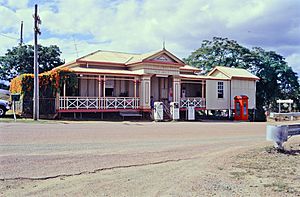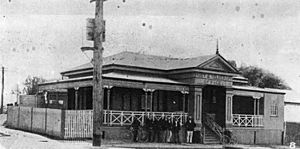Ravenswood Post Office facts for kids
Quick facts for kids Ravenswood Post Office |
|
|---|---|

Ravenswood Post Office, 1997
|
|
| Location | Macrossan Street, Ravenswood, Charters Towers Region, Queensland, Australia |
| Design period | 1870s - 1890s (late 19th century) |
| Built | 1885 |
| Official name: Ravenswood Post Office and Residence | |
| Type | state heritage (built) |
| Designated | 21 October 1992 |
| Reference no. | 600447 |
| Significant period | 1885 (fabric) 1870s-ongoing (historical, social) |
| Significant components | post & telegraph office, residential accommodation - post master's house/quarters |
| Builders | Queensland Public Works Department |
| Lua error in Module:Location_map at line 420: attempt to index field 'wikibase' (a nil value). | |
The Ravenswood Post Office is a historic building located on Macrossan Street in Ravenswood. This town is in the Charters Towers Region of Queensland, Australia. The post office was built in 1885 by the Queensland Public Works Department. It is now listed on the Queensland Heritage Register, which means it's a special building protected for its history.
Contents
A Glimpse into History
The Ravenswood Post Office was built in 1885. It stands at the corner of Macrossan and Raven Streets. Before this building, an older Post and Telegraph Office served the town since 1873.
The Gold Rush Story
Ravenswood was once a very important gold mining town. It was one of many goldfields that helped develop North Queensland. Finding gold often decided where railways were built and where towns grew. Some gold towns were temporary, disappearing quickly. Others, like Ravenswood, became proper towns with government buildings, shops, and homes.
Gold was first found in Ravenswood in 1868. This was a few years after people started settling the area. Miners found gold in "reefs," which are veins of rock containing gold. A small machine called a "battery" was set up in 1869 to crush the gold-bearing rock. The town was officially surveyed in 1870. However, the town's layout was already shaped by the goldfield itself. This is why some main streets are not perfectly straight.
Ravenswood became an official town in 1871. Soon, public buildings like a courthouse, a school, and a Post and Telegraph Station were built. But miners faced problems as they dug deeper. The gold was harder to separate from other minerals. This meant more money was needed for new ways to extract the gold. Many miners left for other goldfields, like Charters Towers, which became more important.
Ravenswood's Growth and Changes
Even with challenges, Ravenswood continued to grow. It was supported by gold mining, even if less gold was found. Silver was also discovered nearby at Totley in 1878. Ravenswood also became a busy trading center. As single miners left, more families moved in. Wooden buildings replaced the early tents and shacks.
The town's economy also got a boost when the railway arrived in 1884. New methods helped extract gold from Ravenswood's ore more easily. In the 1880s, several important public buildings were replaced. This might have been the government's way to help the town grow. A new Court House and Police Station were built in 1882. A new hospital followed in 1887. The current Post Office building replaced the 1873 one in 1885.
A Period of Prosperity and Decline
In 1899, a new company called New Ravenswood Company was formed. It brought in money from overseas. This company reopened old mines and used modern methods to re-process leftover mining waste, called "tailings." This was very successful, and the company made back its money quickly. This period was Ravenswood's most successful, lasting for several years.
However, after 1908, the cost of mining increased. Less gold was being found. After World War I, it became clear that mining wouldn't recover. Rail services were cut in 1916, and the New Ravenswood Company closed in 1917.
In the 1920s, many buildings were moved from Ravenswood to other towns. The town saw a small comeback in the 1930s and early 1940s. New technology allowed for cheaper mining of lower-quality ores. In 1951, the Post Office was sold to private owners, Frank and Dorothy Weinheimer. They continued to run it as a post office.
By the 1960s, Ravenswood's population dropped to just 70 people. This was its lowest point. But then, tourists started to show interest in the town. Studies were done on the historic buildings, and efforts began to protect them. The Post Office was bought by Warren and Fay Crow in 1975. It was then sold to the current owners in 1985. In the 1980s, the entire town was listed by important heritage groups. In 1987, a new open-cut mine opened, using modern methods to extract gold.
Through all these changes, Ravenswood has continued to offer services to the local community. Postal services have been available from this location since 1873, and from the current building since 1885. Today, the Post Office also runs as a small shop selling groceries and other items. The owners live in the residence at the back of the building.
What the Post Office Looks Like
The Post Office and its attached residence are located at the corner of Raven and Macrossan Streets. It's close to the bridge over Elphinstone Creek. The town is in a mining area with disturbed ground, old ruins, and piles of mining waste. You can also see "chinkee apple" trees and rubber vine plants around.
The Post Office is a single-story building made of timber. It has a visible wooden frame and sits on low stumps. The roof is hipped (slopes on all sides) and made of corrugated iron. Verandahs (porches) wrap around three sides of the building. These verandahs are supported by pairs of wooden posts. They have diagonal wooden balustrading (railings) and a decorative cast iron valance (a decorative border). Part of the verandah on the right side is enclosed.
You reach the front verandah and the entrance to the Post Office and store by climbing steps. The central entrance looks like a classic design with a triangular wooden pediment (a triangular top part) supported by square wooden pillars. This grand entrance is a bit hidden by three old petrol pumps in front of the steps.
The residence, where the owners live, is at the back of the Post Office. It's built with similar materials. It also has verandahs around it and a pyramid-shaped corrugated iron roof. A short walkway connects the residence to the Post Office.
Why It's a Heritage Site
The Ravenswood Post Office was added to the Queensland Heritage Register on October 21, 1992. It meets certain important requirements:
- It shows how Queensland's history developed.
Ravenswood was one of the first major gold mining sites in North Queensland. Gold mining greatly boosted the region's economy and social life. The government helped this growth by building important public services like Post and Telegraph Offices. These services were vital for setting up isolated towns, especially those with valuable resources like Ravenswood.
- It shows the main features of its building type.
The Post Office buildings are great examples of their kind. They were built using architectural styles developed by the Public Works Department at that time. This department played a big role in improving building design and construction quality in Queensland.
- It has important aesthetic (beauty) value.
The Post Office is well-designed and stands out as an important public building in the town. Its location, facing both Raven and Macrossan Streets, makes it a significant and noticeable part of Ravenswood's town view.
Images for kids




